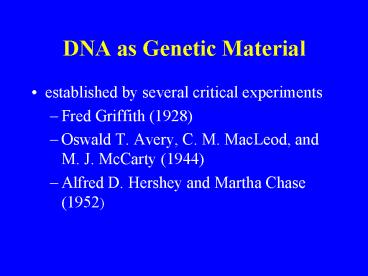DNA as Genetic Material PowerPoint PPT Presentation
1 / 30
Title: DNA as Genetic Material
1
DNA as Genetic Material
- established by several critical experiments
- Fred Griffith (1928)
- Oswald T. Avery, C. M. MacLeod, and M. J. McCarty
(1944) - Alfred D. Hershey and Martha Chase (1952)
2
Discovery of a transforming principle
- Frederick Griffith, 1928
- - Pneumococcus (Streptococcus pneumoniae)
infects mice. - - Mice develop pneumonia and die.
- Two types of bacteria
- S bacteria smooth coat- pneumonia
- R bacteria rough no coat - no pneumonia
Coat type is associated with virulence.
3
(No Transcript)
4
1944 - Avery, MacLeod McCarty
Purified DNA as transforming factor
- Work not well-received
- Protein more complex better able to store
information
Oswald Avery
Colin MacLeod
Maclyn McCarty
5
(No Transcript)
6
1952 - Hershey Chase
Viral DNA (not protein) programs cells
Bacteriophages
Martha Chase Alfred Hershey
7
(No Transcript)
8
(No Transcript)
9
(No Transcript)
10
Radioactive protein (35S)
Centrifuge and measure radioactivity in pellet
and supernatant
T2 Phage
Bacterium
Radioactivity in supernatant, but not pellet
Radioactive phage infects bacterial cells
Blender separates protein coats from bacterial
surface
11
Radioactive DNA (32P)
Radioactivity in pellet, but not supernatant
Therefore, it is the viral DNA, and not protein,
that specifies all the information needed to
synthesize new virus.
12
DNA
- Discovery of the DNA double helix
- A. 1950s
- B. Rosalind Franklin - X-ray photo of DNA.
- C. Watson and Crick - described the DNA
molecule from Franklins X-ray.
13
The Structure of DNA
- Four features summarize the molecular
architecture of DNA - The DNA molecule is a double-stranded helix.
- The diameter of the DNA molecule is uniform.
- The twist in DNA is right-handed.
- The two strands run in different directions (they
are antiparallel).
14
The Structure of DNA
- The sugarphosphate backbones of each strand coil
around the outside of the helix. - The nitrogenous bases point toward the center of
the helix. - Hydrogen bonds between complementary bases hold
the two strands together. - A always pairs with T (two hydrogen bonds).
- G always pairs with C (three hydrogen bonds).
15
Deoxyribonucleic Acid (DNA)
- Made up of nucleotides (DNA molecule) in a DNA
double helix. - Nucleotide
- 1. Phosphate group
- 2. 5-carbon sugar
- 3. Nitrogenous base
- 2 nm wide
16
DNA Nucleotide
17
DNA Double Helix
18
Nitrogenous Bases
- PURINES
- 1. Adenine (A)
- 2. Guanine (G)
- PYRIMIDINES
- 3. Thymine (T)
- 4. Cytosine (C)
19
BASE-PAIRINGS
- Base of
- Purines Pyrimidines Pairs H-Bonds
- Adenine (A) Thymine (T) A T 2
- Guanine (G) Cytosine (C) C G 3
20
21
Chargaffs Rule
- Adenine must pair with Thymine
- Guanine must pair with Cytosine
- Their amounts in a given DNA molecule will be
about the same.
22
Question
- If there is 30 Adenine, how much Cytosine is
present?
23
- There would be 20 Cytosine.
- Adenine (30) Thymine (30)
- Guanine (20) Cytosine (20)
- (50) (50)
24
Synthesis Phase (S phase)
- S phase in interphase of the cell cycle.
- Nucleus of eukaryotes
25
Figure 11.7 Base Pairing in DNA Is Complementary
26
- The genetic material performs four important
functions - It stores all of an organisms genetic
information. - It must be precisely replicated in the cell
division cycle. - It is expressed as the phenotype.
- It is susceptible to mutation.
27
Watson Crick predicted that each DNA strand
could serve as a template for the replication of
a new strand
Q What is the mode of replication?
28
Three possible modes of replication
29
The Meselson-Stahl Experiment
- The Meselson-Stahl experiment
demonstrated that replication is
semiconservative - This experiment took advantage of
the fact that nucleotide bases contain
nitrogen - Thus DNA contains nitrogen
- The most common form of Nitrogen is N14 with 7
protons and 7 neutrons - N15 is called heavy nitrogen as it has 8
neutrons thus increasing its mass by 1 atomic
mass unit
30
The Meselson-Stahl Experiment
X
The conservative and dispersive models make
predictions that do not come true thus, by
deduction, the semi-conservative model must be
true.
Prediction after 2 or more replications
X

